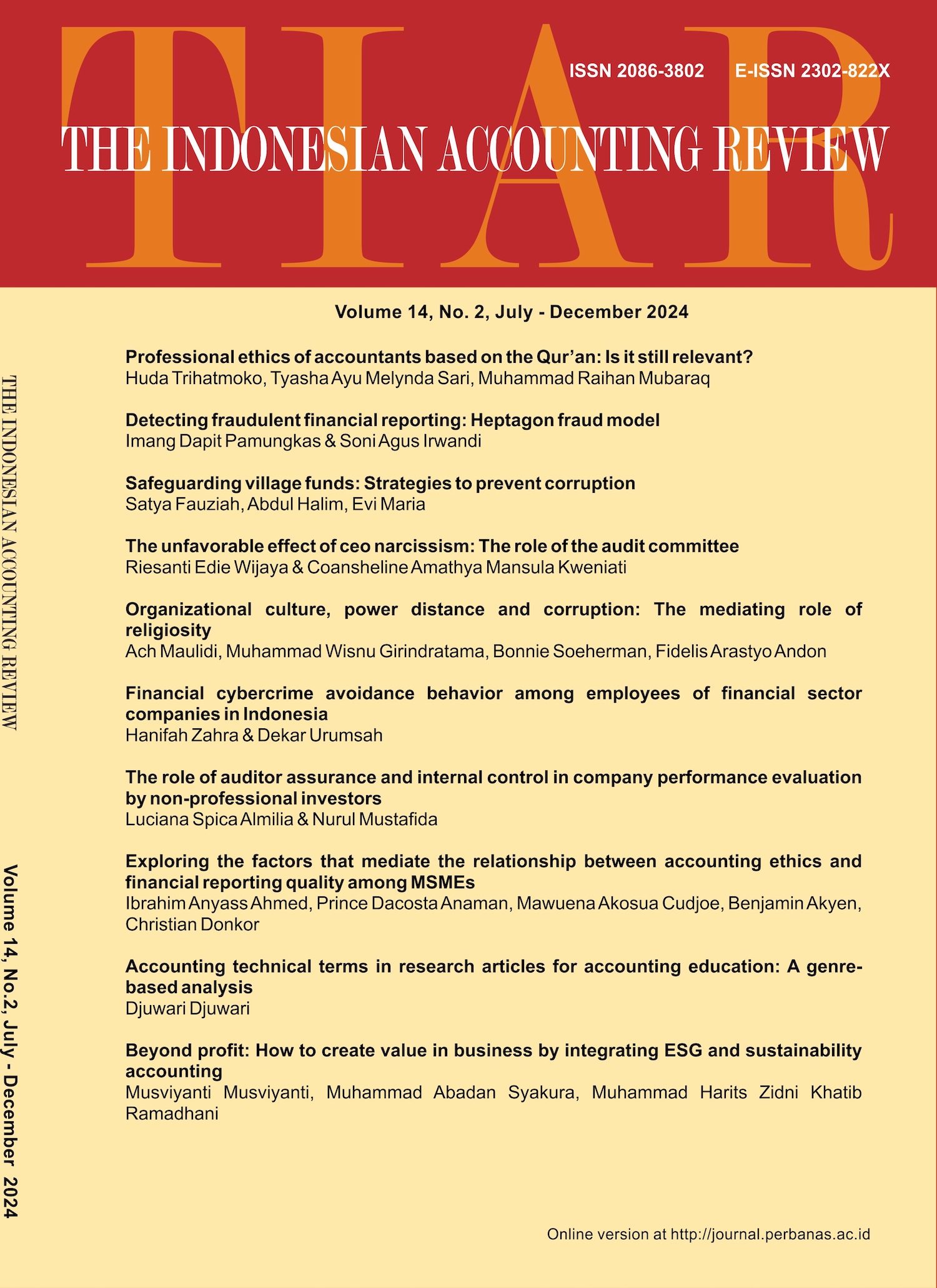Financial cybercrime avoidance behavior among employees of financial sector companies in Indonesia
DOI:
https://doi.org/10.14414/tiar.v14i2.4596Keywords:
Avoidance behavior, Avoidance motivation, Financial cybercrimeAbstract
This study aims to examine the factors that influence the behavior of avoiding financial cybercrime among employees of financial sector companies in Indonesia. This studyuses Technology Threat Avoidance Theory (TTAT) and Regret Theory as theoretical frameworks. Data are collected through a survey conducted onemployees of financial sector companies in Indonesia, both in paper-based and online formats, resulting in a total of 180 questionnaires for analyses. Data analysis is conducted using Structural Equation Modeling-Partial Least Squares (SEM-PLS) in SmartPLS 4.0. The results of this study show thatperceived susceptibility and perceived severity have a significant positive influence on perceived threat. However, the interaction between perceived susceptibility and perceived severity has no effect on perceived threat. Perceived threat, safeguard effectiveness, and anticipated regret have a significant influence on financial cybercrime avoidance motivation. Conversely, self-efficacy and safeguard cost do not have an effect onfinancial cybercrime avoidance motivation. Furthermore, financial cybercrime avoidance motivation has a significant and positive influence on financial cybercrime avoidance behavior. These findings offer insights for policymakers, financial sector companies, and antivirus software developers to enhance cybersecurity policies, responses to cybercrime, and software features.
References
Arachchilage, N. A. G., Love, S., & Beznosov, K. (2016). Phishing Threat Avoidance Behaviour: An Empirical Investigation. Computers in Human Behavior, 60, 185–197. https://doi.org/https://doi.org/10.1016/j.chb.2016.02.065.
Baker, A. W., Keshaviah, A., Horenstein, A., Goetter, E. M., Mauro, C., Reynolds, C. F., Zisook, S., Katherine Shear, M., & Simon, N. M. (2016). The Role of Avoidance in Complicated Grief: A Detailed Examination of the Grief-Related Avoidance Questionnaire (GRAQ) in a Large Sample of Individuals with Complicated Grief. Journal of Loss and Trauma, 21(6), 533–547. https://doi.org/10.1080/15325024.2016.1157412.
Bax, S., McGill, T., & Hobbs, V. (2021). Maladaptive Behavior in Response to Email Phishing Threats: The Roles of Rewards and Response Costs. Computers and Security, 106, 1–15. https://doi.org/10.1016/j.cose.2021.102278.
Bell, D. E. (1982). Regret in Decision Making Under Uncertainty. Operations Research, 30(5), 961–981. https://doi.org/doi:10.1287/opre.30.5.961.
Bennett, M., & Galpert, L. (1992). Complex Belief-Desire Reasoning in Children. Social Development, 1(3), 201–210. https://doi.org/https://doi.org/10.1111/j.1467-9507.1992.tb00124.x.
Brewer, N. T., DeFrank, J. T., & Gilkey, M. B. (2016). Anticipated regret and health behavior: A meta-analysis. Health Psychology, 35(11), 1264–1275. https://doi.org/10.1037/hea0000294.
Butler, R. (2020). A Systematic Literature Review of The Factors Affecting Smartphone User Threat Avoidance Behaviour. Information and Computer Security, 28(4), 555–574). https://doi.org/10.1108/ICS-01-2020-0016.
Carpenter, D., Young, D. K., Barrett, P., & McLeod, A. J. (2019). Refining technology threat avoidance theory. Communications of the Asso-ciation for Information Systems, 44(1), 380–407. https://doi.org/10.17705/1CAIS.04422.
Fishburn, P. C. (1982). The Foundations of Expected Utility. D. Reidel. Springer.
Gillam, A. R., & Foster, W. T. (2020). Factors Affecting Risky Cybersecurity Behaviors by U.S. Workers: An Exploratory Study. Computers in Human Behavior, 108, 1–12. https://doi.org/10.1016/j.chb.2020.106319.
Gupta, B. B., Perez, G. M., Agrawal, D. P., & Gupta, D. (2020). Handbook of Computer Networks and Cyber Security (1st ed.). Springer International Publishing.
Hair, J. F., Risher, J. J., Sarstedt, M., & Ringle, C. M. (2019). When to use and how to report the results of PLS-SEM. European Business Review, 31(1), 2–24. https://doi.org/10.1108/EBR-11-2018-0203.
Henseler, J., Ringle, C. M., & Sarstedt, M. (2015). A new criterion for assessing discriminant validity in variance-based structural equation modeling. Journal of the Academy of Marketing Science, 43(1), 115–135. https://doi.org/10.1007/s11747-014-0403-8.
IBM. (2022). X-Force Threat Intelligence Index 2022 Full Report. IBM Security.
Jenab, K., & Moslehpour, S. (2016). Cyber Security Management: A Review. Business Management Dynamics, 5(11), 16–39.
Kasmaei, P., Shokravi, F. A., Hidarnia, A., Hajizadeh, E., Atrkar-Roushan, Z., Shirazi, K. K., & Montazeri, A. (2014). Brushing Behavior Among Young Adolescents: Does Perceived Severity Matter. BMC Public Health, 14(8), 1-6. https://doi.org/10.1186/1471-2458-14-8.
Liang, H., & Xue, Y. (2009). Avoidance of Information Technology Threats: A Theoretical Perspective. MIS Quarterly: Management Information Systems, 33(1), 71–90. https://doi.org/10.2307/20650279.
Liang, H., & Xue, Y. (2010). Understanding Security Behaviors in Personal Com-puter Usage: A Threat Avoidance Perspective. Journal of the Association for Information Systems, 11(7), 394–413. https://doi.org/10.17705/1jais.00232
Loomes, G., & Sugden, R. (1982). Regret Theory: An Alternative Theory of Rational Choice Under Uncertainty. The Economic Journal, 92(368), 805–824. https://doi.org/https://doi.org/10.2307/2232669.
Mark, M. S., Borda, O., Stroman, J., Member, C., & Wilson, T. C. (2021). An Analysis of Factors Influencing Phishing Threat Avoidance Behavior: A Quantitative Study. Computers in Human Behavior, 60, 185–197.
NCSI. (2022). National Cyber Security Index - Indonesia. National Cyber Security Index.
PwC. (2022). PwC’s Global Economic Crime and Fraud Survey 2022. PwC.
Saidi, K., & Prayudi, Y. (2021). Analisis Indikator Utama Dalam Information Security-Personality Threat Terhadap Phishing Attack Menggunakan Metode Technology Threat Avoidance Theory (TTAT). JUSTINDO (Jurnal Sistem dan Teknologi Informasi Indonesia), 6(1), 21-30
Shih, E., & Schau, H. J. (2011). To Justify or Not to Justify: The Role of Anticipated Regret on Consumers’ Decisions to Upgrade Technological Innovations. Journal of Retailing, 87(2), 242–251. https://doi.org/https://doi.org/10.1016/j.jretai.2011.01.006.
Shmueli, G., Sarstedt, M., Hair, J. F., Cheah, J. H., Ting, H., Vaithilingam, S., & Ringle, C. M. (2019). Predictive model assessment in PLS-SEM: guidelines for using PLSpredict. European Journal of Marketing, 53(11), 2322–2347. https://doi.org/10.1108/EJM-02-2019-0189.
Sukamulja, S., Meilita, A. Y. N., & Senoputri, D. (2019). Regret Aversion Bias, Mental Accounting, Overconfidence, and Risk Perception in Investment Decision Making on Generation Y Workers in Yogyakarta. International Journal of Economics and Management Studies, 6(7), 102–110. https://doi.org/10.14445/23939125/ijems-v6i7p116.
Sylvester, F. L. (2022). Mobile Device Users’ Susceptibility to Phishing Attacks. International Journal of Computer Science and Information Technology, 14(1), 1–18. https://doi.org/10.5121/ijcsit.2022.14101.
Tang, Z., Miller, A. S., Zhou, Z., & Warkentin, M. (2021). Does government social media promote users’ information security behavior towards COVID-19 scams? Cultivation effects and protective motivations. Government Information Quarterly, 38(2), 1-11. https://doi.org/10.1016/j.giq.2021.101572.
Verkijika, S. F. (2019). If You Know What to Do, Will You Take Action to Avoid Mobile Phishing Attacks: Self-Efficacy, Anticipated Regret, and Gender. Computers in Human Behavior, 101, 286–296. https://doi.org/https://doi.org/10.1016/j.chb.2019.07.034.
Xiling, H., Yuli, Z., Yiran, L., & Yan-ping, P. (2018). A Theoretical Framework for Counterfactual Thinking in The Context of Entrepreneurial Failure. Foreign Economics and Management, 40, 3–15. https://doi.org/10.16538/j.cnki.fem.2018.04.001.
Downloads
Submitted
Published
How to Cite
Issue
Section
License
Copyright (c) 2025 The Indonesian Accounting Review

This work is licensed under a Creative Commons Attribution-NonCommercial 4.0 International License.


















